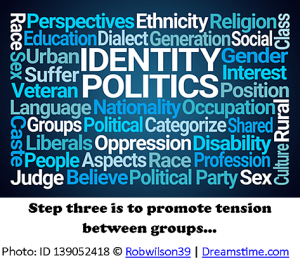Developing and Sustaining Thought Deprivation (Part 2)
 13 March 2019
13 March 2019
This is the second in a series of columns. Here is the opening from the first column and will be repeated in each column in this series:
There is a dangerous, but tremendously effective, political approach being employed in America. It could be called “Thought Deprivation”. That is, conditioning people so that they do not think with depth regarding the issues that face us as a nation. Sadly, allowing this “Thought Deprivation” approach to become routine and embedded in the political process has brought us to a point of real danger in the governing, and very survival, of this nation.
My observations as to how “thought deprivation” is developed and sustained in a person, by others, were presented as a seven step process. The first two steps were addressed in the last column. Steps three and four will be explored here.
Step three is to promote tension between groups or groups of groups. The examples as to how this component is developed are numerous. The fermenting of tensions between blacks and whites in America immediately comes to mind. It is disheartening, and downright disgusting, how race is used to create tension between these two groups in our country.
However, as we approach the 2020 election, using the race grouping approach is taking second position to grouping citizens by financial status and pitting one group against the other. The primary groups appear to be the wealthy on one hand and everybody else on the other. As Democratic presidential candidates are announcing their candidacy, or publically contemplating doing so, the cry is that America’s wealthy should pay more in taxes to provide a myriad of benefits for the rest of us. This argument for higher taxes on some and wealth redistribution is not put forth as a thoughtful presentation of facts coupled with reasonable analysis. Consequently, citizens are not encouraged to think through what is being proposed.
An example of this call for increased tax payments from the wealthy is the “wealth tax” being proposed by Senator Elizabeth Warren (Dem, MA), presidential candidate. The plan is
described, as follows, in an article by Neil Irwin titled, “Elizabeth Warren Wants a Wealth Tax. How Would That Even Work?” The following segments from that article highlight the process of dividing us into groups and creating tension between groups:
Developed by Emmanuel Saez and Gabriel Zucman, two University of California, Berkeley, economists who are leading scholars of inequality, the proposal is to tax a family’s wealth above $50 million at 2 percent a year, with an additional surcharge of 1 percent on wealth over $1 billion.
Ms. Warren and other advocates of a wealth tax argue that this accumulation of untaxed or lightly taxed wealth is a bad thing. They say that it enables the creation of democracy-distorting dynasties who accumulate political power, and that tax policy should be used to rein them in more than the current tax code does.
The wealth tax proposal, and the commentary in support of it, draw a clear line between the wealthy and the rest of us. That line-drawing, especially, shows through in the reason given for imposing such a tax. That is, the wealthy must be prevented from gaining political power that is made possible by their wealth.
This separating of Americans into the wealthy and the rest of us, while creating tension between the two groups, might be a bit subtle in Warren’s presentation. That is definitely not the case with Senator Bernie Sanders (Independent, VT) who has entered the 2020 presidential race. Consider the following segments from Catherine Clifford’s article titled, “Bernie Sanders: America is ‘owned and controlled by a small number of multi-billionaires’”:
“We live in a nation owned and controlled by a small number of multi-billionaires whose greed, incredible greed, insatiable greed, is having an unbelievably negative impact on the fabric of our entire country,” Sanders told Paul Jay, CEO and senior editor of The Real News Network, in an interview posted Thursday.
“What you have here is, first of all, massive income and wealth inequality. And as a nation we have got to think from a moral perspective and an economic perspective whether we think it is appropriate that three people, one, two, three, own more wealth than the bottom half of the American society,” Sanders said. (A November 2017 report published by the progressive think tank Institute for Policy Studies found that Bill Gates, Jeff Bezos and Warren Buffett collectively had more wealth than the 160 million poorest Americans, or half the population of the United States.)
The following statement from the homepage of Bernie Sanders’ website makes the effort to divide and create tension crystal clear: “No one candidate, not even the greatest candidate you
could imagine, is capable of taking on Donald Trump and the billionaire class alone. There is only one way we win — and that is together.”
Warren and Sanders are not alone in their “divide into groups and create tension” strategy. It is a strategy that has been employed by Democrats for years. As of today, 19 February 2019, every Democrat who has announced as a 2020 presidential candidate is singing from the same sheet as Warren and Sanders. They stay with this approach because it has worked in the past and, given the 2018 Democratic gains in the House of Representatives, they have reason to believe it will work in the 2020 election cycle.
Grouping people and promoting tension between the groups is not, alone, sufficient to garner the political power that is sought by those who engage in developing and sustaining thought deprivation. The fourth necessary step is to contend that some groups are victimized, mistreated, discriminated against, etc. Again, the most obvious employment of this step is reflected in Democrats constantly, toward Republicans, alleging racism against Black Americans at every opportunity, no matter how baseless the accusation might be.
However, this step also clearly shows in Democrats employing the “wealthy vs the rest of us” strategy. The positions staked out above by Warren and Sanders illustrate this point, too. Look at how the wealthy are described by them: Untaxed, or lightly taxed, which is a bad thing; pose the threat of democracy-distorting dynasties; are greedy, extremely greedy; have a negative impact on the fabric of our country; hold too much wealth. Then there is the emphasis on income inequality coupled with having a large portion of America’s wealth held by a few people being morally and economically questionable. This is to say that all of us who are not wealthy are being mistreated by the wealthy.
The solution proposed by Warren, Sanders, other Democratic presidential candidates, and, apparently, most Democratic voters, is to tax the wealthy at higher rates. The common statement is that “the wealthy should pay their fair share”. At the bottom line, the prevailing argument is that the wealthy have too much money and it allows them to wield political power at a level that is dangerous for the nation. If too much political power is the concern, just take money from the wealthy and burn it. That will not happen because the Democratic effort is about gaining the support of the masses to which they redistribute wealth that is garnered by increasing taxes on the wealthy.
In the end, Democrats are working a strategy to gain political power. They are doing so by dividing us into groups and pitting one group against another; then using what is taken from the wealthy to, cheaply and through legal means, buy the votes of the non-wealthy. Thought deprivation is essential to the success of this strategy. Talk about immoral, greedy, and democracy-distorting: this is it.
Next time, more on steps to developing and sustaining thought deprivation.
Note: In Karl Merritt’s recent column titled, “God, Save Us from Ourselves,” it was stated that Covington Catholic High School is in Frankfort, KY. The school is actually in Park Hills, KY.




